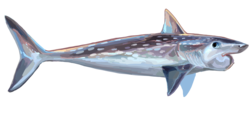| Eugeneodontiformes Temporal range: Early Carboniferous (Serpukhovian) to Early Triassic (Olenekian) | |
|---|---|
 | |
| Helicoprion davisii | |
 | |
| Edestus heinrichi | |
| Scientific classification | |
| Kingdom: | Animalia |
| Phylum: | Chordata |
| Class: | Chondrichthyes |
| Order: | † Eugeneodontiformes Zangerl, 1981 |
| Families | |
See text | |
| Synonyms | |
| |


Eugeneodontiformes (also called Eugeneodontida) is an extinct and poorly known order of cartilaginous fishes. They possessed "tooth-whorls" on the symphysis of either the lower or both jaws and pectoral fins supported by long radials. They probably lacked pelvic fins and anal fins. [1] The palatoquadrate was either fused to the skull or reduced. They are now determined to be within the Holocephali; their closest living relatives are chimaeras. [2] The eugeneodonts are named after paleontologist Eugene S. Richardson, Jr. [3] The group first appeared in the fossil record during the late Mississippian (Serpukhovian). [4] The youngest eugeneodonts are known from the Early Triassic. [5] The geologically youngest fossils of the group are known from the Sulphur Mountain Formation (western Canada), Vardebukta Formation (Svalbard, Norway) and Wordie Creek Formation (Greenland).
Contents
Members of the Eugeneodontiformes are further classified into two superfamilies and either four or five different families. The Helicoprionidae and Edestidae are assigned to the superfamily Edestoidea, the former containing genera such as Helicoprion , Sarcoprion , and Parahelicoprion , and the latter containing the genera such as Edestus and Lestrodus . The family Helicampodontidae has been used for genera that do not closely resemble typical members of either of these two groups. [6] The superfamily Eugeneodontoidei (traditionally Caseodontoidea) [7] includes the families Caseodontidae and Eugeneodontidae, which were smaller and less-specialized than the edestoids. [3] Eugeneodonts were predatory, with eugeneodontoids likely being generalist feeders and some edestoids being specialized for hunting cephalopods. [1] [3] [8]
Among the eugeneodonts, some members of the superfamily Edestoidea are probably the largest marine animals of their time, with the Late Carboniferous Edestus estimated to reach about or exceeding 6.7 metres (22 ft) in length, [9] [10] with some Early Permian Helicoprion suggested to be over 7.6 metres (25 ft) long by some estimates (though the body length estimates for both genera are somewhat speculative due to both only being known from skull material). [9] [10] [8]








